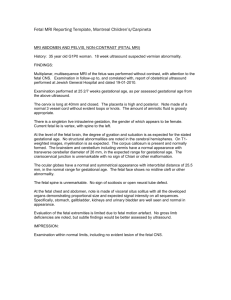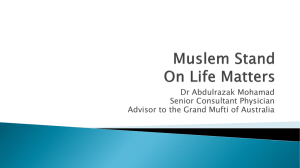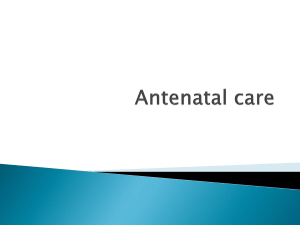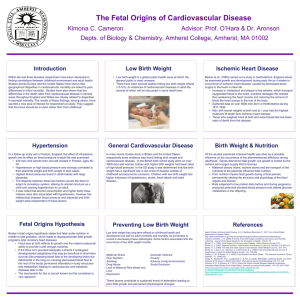mins 16 jan 13
advertisement
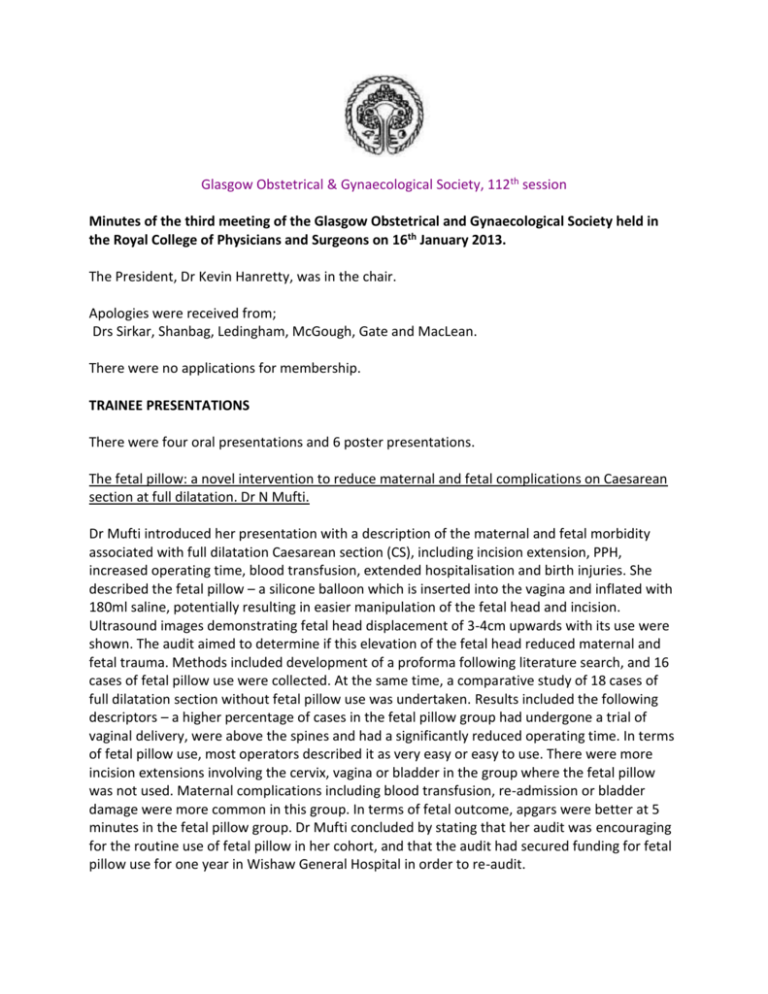
Glasgow Obstetrical & Gynaecological Society, 112th session Minutes of the third meeting of the Glasgow Obstetrical and Gynaecological Society held in the Royal College of Physicians and Surgeons on 16th January 2013. The President, Dr Kevin Hanretty, was in the chair. Apologies were received from; Drs Sirkar, Shanbag, Ledingham, McGough, Gate and MacLean. There were no applications for membership. TRAINEE PRESENTATIONS There were four oral presentations and 6 poster presentations. The fetal pillow: a novel intervention to reduce maternal and fetal complications on Caesarean section at full dilatation. Dr N Mufti. Dr Mufti introduced her presentation with a description of the maternal and fetal morbidity associated with full dilatation Caesarean section (CS), including incision extension, PPH, increased operating time, blood transfusion, extended hospitalisation and birth injuries. She described the fetal pillow – a silicone balloon which is inserted into the vagina and inflated with 180ml saline, potentially resulting in easier manipulation of the fetal head and incision. Ultrasound images demonstrating fetal head displacement of 3-4cm upwards with its use were shown. The audit aimed to determine if this elevation of the fetal head reduced maternal and fetal trauma. Methods included development of a proforma following literature search, and 16 cases of fetal pillow use were collected. At the same time, a comparative study of 18 cases of full dilatation section without fetal pillow use was undertaken. Results included the following descriptors – a higher percentage of cases in the fetal pillow group had undergone a trial of vaginal delivery, were above the spines and had a significantly reduced operating time. In terms of fetal pillow use, most operators described it as very easy or easy to use. There were more incision extensions involving the cervix, vagina or bladder in the group where the fetal pillow was not used. Maternal complications including blood transfusion, re-admission or bladder damage were more common in this group. In terms of fetal outcome, apgars were better at 5 minutes in the fetal pillow group. Dr Mufti concluded by stating that her audit was encouraging for the routine use of fetal pillow in her cohort, and that the audit had secured funding for fetal pillow use for one year in Wishaw General Hospital in order to re-audit. The under detection of cleft lip +/- palate at the 20 week anomaly scan in Forth Valley Royal Hospital. Dr L MacDonald. Dr MacDonald described RCOG evidence that anomaly detection rates are approximately 50%, and that cleft lip +/- palate detection is quoted as 17-95%. Prevalence of cleft lip +/- palate is 1.5/1000 live births and is described as a serious handicap. The purpose of the audit was to determine rates of cleft detection at the 20 week anomaly scan at Forth Valley Hospital, and note recorded complicating factors for detection including fetal position, oligohydramnios or maternal obesity. Dr MacDonald corresponded with the Cleft Nurse team at the RHSC and collected 8 cases of cleft lip +/- palate from January 11- Oct 12, of the 4802 scans performed. Detection antenatally at scan or after birth was recorded. Six of the eight cases were a missed diagnosis at anomaly scan (75%), and risk factors for under detection included maternal obesity on 3 cases. Of interest, all fetuses were male, 2 mothers were obese, and only once case had a positive family history – all risk factors for cleft. Dr MacDonald indicated that detection of such an anomaly is important so that parents can have time to adjust and adapt to the diagnosis and allows timely referral to the cleft service. Other associated malformations may also be detected. The audit concluded that the facial image should be included in the basic minimum standard for anomaly scanning in Forth Valley Hospital, which would require sonographer training. Primary infertility referrals to the gynaecology clinic in Glasgow South – can we improve the patient journey? Dr Teegala. Dr Teegala described the National Patient Pathway for NHS Scotland – Infertility, demonstrating the key role primary care play in performing preliminary investigations and counselling. Adherence to the guidance is paramount in order to reduce delays to treatment, minimise multiple clinic appointments and improve patient satisfaction with gynaecology review. She hypothesised that a significant number of patients referred to the gyn clinic would not have these investigations performed prior to referral. The audit was a retrospective case note analysis from 01.03.11 – 31.08.11 of cases at an infertility clinic in the Victoria Infirmary. 52 cases were analysed and 48% were referred early for reasons including maternal age, oligomenorrhoea, PCOS, STD and abnormal semen analysis. Rubella status was checked in only 25% of cases, Chlamydia test performed in 12% and mid-luteal progesterone test performed in 71%. A single semen sample result was available for 56% and 2 available for 23%. Other tests, not indicated in the patient pathway, were also performed in certain cases and were described. Dr Teegala was able to demonstrate a lack of compliance with the NHS Scotland national patient pathway, and discussed reasons for why this is important. Available results may promote appropriate early referral, allow GP counselling, reduce clinic visits and expedite onward referral for assisted conception. Cost efficacy for secondary care was also discussed. A city-wide check list, possibly electronic, was suggested to deal with the deficiencies and re-audit after a period of use. How to reduce cervical screening defaulter rates in Dumfries and Galloway? Evidence from single-centre multiple studies. Dr Wedisinghe. 6231 cervical cancers were diagnosed in England last year. 71% of these cancers occurred in women who had undergone cervical smear test greater than 3.5 years ago. Dr Wedisinghe described self-sampling for HPV screening, with a low uptake of only 6% in a recent UK study. In his study, he identified women not up to date with their smears and provided them with a letter of options including attending the GP or the hospital for a smear, attending the hospital for HPV testing, performing the HPV test at home, asking for a member of staff to contact the patient or to decline any further action. Cases were identified from SCCRS, of defaulters from smear testing who were over 30 years old. Once test results were available, options included colposcopy referral for those HPV positive and smear positive or repeat testing in one year for patients who were HPV positive but smear negative. If HPV test result was negative, routine recall was advised. The HPV sample was sent out via Royal Mail and a website homepage was used as a point of contact for patients. Results were available from 30% of cases in phase 2 of the trial where the test was sent to patients, and of the first 50 samples, all but one HPV positive case attended for a cervical smear. The sensitivity of vaginal self sampling was described as high, with a high negative predictive value. Self sampling was described as easy in 100% of cases, and 99% said they would take part in the future if self-sampling was an option. Positive outcomes from this study included a reduction in defaulters by 733 in 8 months, cost effectiveness of self-sampling and patient acceptability of the HPV screening test. Positive outcomes of screening include a reduction in morbidity and mortality. The future of this study includes development of a urine test for HPV, a larger study in Scotland and development of the National Screening Programme. All speakers received a number of questions from the audience. Drs Owen, Bjornsson and Malcolm judged the trainees’ presentations. The judges retired to make their deliberations. Dr Hanretty proceeded to the business of the AGM. The following points were discussed: The treasurers report included a spend of £6666 and income of £6839 this year – both increased compared with the previous year. The balance is £12742. Dr Gaudoin highlighted a need for improved sponsorship. Honorary Fellowship nominations for 2013 were invited, in writing, to Dr Vanessa Mackay. Council recommended 3 new members – Dr Sicar Sirkar, Dr Janice Gibson and Dr Rita Panigrahy and all were accepted into council. Catering issues and expenditure were discussed. It was proposed that the SCRCOG secretariat may be able to assist with reduced fees in RCPSG. An alternative meeting format was proposed, including a reduction in meeting number and alternative locations. Timing of the meeting to afternoons was suggested. Dr Mackay will survey members to collect opinion. TRAINEE POSTER PRIZE The winner of the poster prize was Dr N Ray-Gaheer for Fertility outcomes after reversal of sterilisation in a DGH. MEDICAL STUDENT ESSAY PRIZE This was awarded to Donncha Mullin for his essay titled Working with interpreters in Sexual Health; an audit. This essay can be found on the website. Special commendation was made to Dr Sawati for his poster as the work was undertaken while a medical student. TRAINEE ORAL PRESENTATION PRIZE The winner of the oral presentation prize was Dr Lindsay MacDonald. AOCB Dr Hanretty closed the meeting by thanking the speakers and everyone involved. Dr Hanretty thanked the sponsors for their generous support and reminded the society that the next meeting will take place on 20th February 2013. …………………………………………………President





